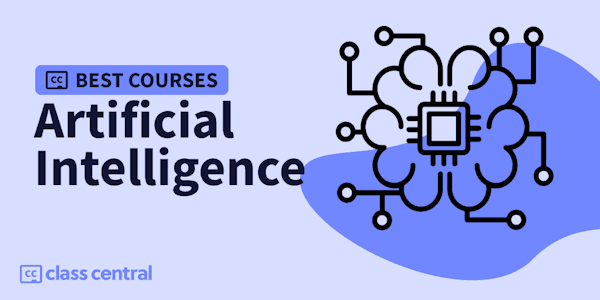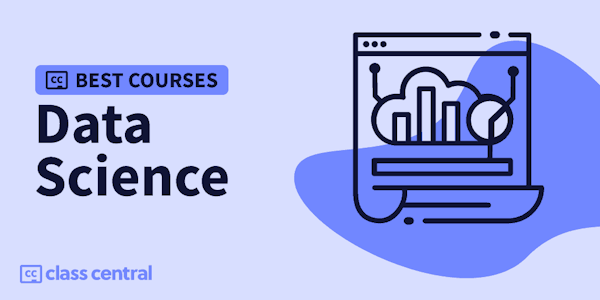Overview
Class Central Tips
Prepare for a career in the high-growth field of data analytics. In this program, you’ll learn in-demand skills like Python, Excel, and SQL to get job-ready in as little as 4 months.
Data analysis is the process of collecting, storing, modeling, and analyzing data that can inform executive decision-making, and the demand for skilled data analysts has never been greater.
This program will teach you the foundational data skills employers are seeking for entry-level data analytics roles. It will not only help you start your career in data analytics, but also provides a strong foundation for future career development in other paths such as data science, artificial intelligence, deep learning, or data engineering.
You’ll learn the latest skills and tools used by professional data analysts including Excel spreadsheets, Python, Pandas, Numpy, Jupyter Notebooks, Cognos Analytics, and more. You’ll work with a variety of data sources and project scenarios to gain practical experience with data manipulation and applying analytical skills.
When you complete the full program, you’ll have a portfolio of projects and a Professional Certificate from IBM to showcase your expertise. You’ll also earn an IBM Digital badge and will gain access to career resources to help you in your job search, including mock interviews and resume support.
This program is ACE® and FIBAA recommended—when you complete, you can earn up to 12 college credits and 6 ECTS credits.
Syllabus
Course 1: Introduction to Data Analytics
- Offered by IBM. Ready to start a career in Data Analysis but don’t know where to begin? This course presents you with a gentle introduction ... Enroll for free.
Course 2: Excel Basics for Data Analysis
- Offered by IBM. Spreadsheet tools like Excel are an essential tool for working with data - whether for data analytics, business, marketing, ... Enroll for free.
Course 3: Data Visualization and Dashboards with Excel and Cognos
- Offered by IBM. Learn how to create data visualizations and dashboards using spreadsheets and analytics tools. This course covers some of ... Enroll for free.
Course 4: Python for Data Science, AI & Development
- Offered by IBM. Kickstart your learning of Python with this beginner-friendly self-paced course taught by an expert. Python is one of the ... Enroll for free.
Course 5: Python Project for Data Science
- Offered by IBM. This mini-course is intended to for you to demonstrate foundational Python skills for working with data. This course ... Enroll for free.
Course 6: Databases and SQL for Data Science with Python
- Offered by IBM. Working knowledge of SQL (or Structured Query Language) is a must for data professionals like Data Scientists, Data Analysts ... Enroll for free.
Course 7: Data Analysis with Python
- Offered by IBM. Analyzing data with Python is an essential skill for Data Scientists and Data Analysts. This course will take you from the ... Enroll for free.
Course 8: Data Visualization with Python
- Offered by IBM. One of the most important skills of successful data scientists and data analysts is the ability to tell a compelling story ... Enroll for free.
Course 9: IBM Data Analyst Capstone Project
- Offered by IBM. By completing this final capstone project you will apply various Data Analytics skills and techniques that you have learned ... Enroll for free.
- Offered by IBM. Ready to start a career in Data Analysis but don’t know where to begin? This course presents you with a gentle introduction ... Enroll for free.
Course 2: Excel Basics for Data Analysis
- Offered by IBM. Spreadsheet tools like Excel are an essential tool for working with data - whether for data analytics, business, marketing, ... Enroll for free.
Course 3: Data Visualization and Dashboards with Excel and Cognos
- Offered by IBM. Learn how to create data visualizations and dashboards using spreadsheets and analytics tools. This course covers some of ... Enroll for free.
Course 4: Python for Data Science, AI & Development
- Offered by IBM. Kickstart your learning of Python with this beginner-friendly self-paced course taught by an expert. Python is one of the ... Enroll for free.
Course 5: Python Project for Data Science
- Offered by IBM. This mini-course is intended to for you to demonstrate foundational Python skills for working with data. This course ... Enroll for free.
Course 6: Databases and SQL for Data Science with Python
- Offered by IBM. Working knowledge of SQL (or Structured Query Language) is a must for data professionals like Data Scientists, Data Analysts ... Enroll for free.
Course 7: Data Analysis with Python
- Offered by IBM. Analyzing data with Python is an essential skill for Data Scientists and Data Analysts. This course will take you from the ... Enroll for free.
Course 8: Data Visualization with Python
- Offered by IBM. One of the most important skills of successful data scientists and data analysts is the ability to tell a compelling story ... Enroll for free.
Course 9: IBM Data Analyst Capstone Project
- Offered by IBM. By completing this final capstone project you will apply various Data Analytics skills and techniques that you have learned ... Enroll for free.
Courses
-
Working knowledge of SQL (or Structured Query Language) is a must for data professionals like Data Scientists, Data Analysts and Data Engineers. Much of the world's data resides in databases. SQL is a powerful language used for communicating with and extracting data from databases. In this course you will learn SQL inside out- from the very basics of Select statements to advanced concepts like JOINs. You will: -write foundational SQL statements like: SELECT, INSERT, UPDATE, and DELETE -filter result sets, use WHERE, COUNT, DISTINCT, and LIMIT clauses -differentiate between DML & DDL -CREATE, ALTER, DROP and load tables -use string patterns and ranges; ORDER and GROUP result sets, and built-in database functions -build sub-queries and query data from multiple tables -access databases as a data scientist using Jupyter notebooks with SQL and Python -work with advanced concepts like Stored Procedures, Views, ACID Transactions, Inner & Outer JOINs through hands-on labs and projects You will practice building SQL queries, work with real databases on the Cloud, and use real data science tools. In the final project you’ll analyze multiple real-world datasets to demonstrate your skills.
-
Analyzing data with Python is an essential skill for Data Scientists and Data Analysts. This course will take you from the basics of data analysis with Python to building and evaluating data models. Topics covered include: - collecting and importing data - cleaning, preparing & formatting data - data frame manipulation - summarizing data - building machine learning regression models - model refinement - creating data pipelines You will learn how to import data from multiple sources, clean and wrangle data, perform exploratory data analysis (EDA), and create meaningful data visualizations. You will then predict future trends from data by developing linear, multiple, polynomial regression models & pipelines and learn how to evaluate them. In addition to video lectures you will learn and practice using hands-on labs and projects. You will work with several open source Python libraries, including Pandas and Numpy to load, manipulate, analyze, and visualize cool datasets. You will also work with scipy and scikit-learn, to build machine learning models and make predictions. If you choose to take this course and earn the Coursera course certificate, you will also earn an IBM digital badge.
-
Visualizing data is used by virtually every discipline these days. It is used for analyzing web traffic to determine peak server load, growth and death rate of populations for biological analysis, analyzing weather patterns over time, stock market trends, and so on. Simply put, Data Visualization brings meaning to numbers that help people understand it. Seeing the data change can draw attention to trends and spikes that may otherwise go unnoticed. Python is an open-source (free) programming language has libraries that can be used to read and make useful graphics to present the data. In this course, you will create an application that reads data from CSV files. You will learn how to visualize the data using various techniques using existing Python libraries. Note: This course works best for learners who are based in the North America region. We’re currently working on providing the same experience in other regions.
-
Kickstart your learning of Python with this beginner-friendly self-paced course taught by an expert. Python is one of the most popular languages in the programming and data science world and demand for individuals who have the ability to apply Python has never been higher. This introduction to Python course will take you from zero to programming in Python in a matter of hours—no prior programming experience necessary! You will learn about Python basics and the different data types. You will familiarize yourself with Python Data structures like List and Tuples, as well as logic concepts like conditions and branching. You will use Python libraries such as Pandas, Numpy & Beautiful Soup. You’ll also use Python to perform tasks such as data collection and web scraping with APIs. You will practice and apply what you learn through hands-on labs using Jupyter Notebooks. By the end of this course, you’ll feel comfortable creating basic programs, working with data, and automating real-world tasks using Python. This course is suitable for anyone who wants to learn Data Science, Data Analytics, Software Development, Data Engineering, AI, and DevOps as well as a number of other job roles.
-
Spreadsheet tools like Excel are an essential tool for working with data - whether for data analytics, business, marketing, or research. This course is designed to give you a basic working knowledge of Excel and how to use it for analyzing data. This course is suitable for those who are interested in pursuing a career in data analysis or data science, as well as anyone looking to use Excel for data analysis in their own domain. No prior experience with spreadsheets or coding is required - all you need is a device with a modern web browser and the ability to create a Microsoft account to access Excel online at no cost. If you have a desktop version of Excel, you can also easily follow along with the course. Throughout this course, you'll gain valuable experience working with data sets and spreadsheets. We'll start by introducing you to spreadsheets like Microsoft Excel and Google Sheets, and show you how to load data from multiple formats. From there, you'll learn how to perform basic data wrangling and cleansing tasks using functions, and expand your knowledge of data analysis through the use of filtering, sorting, and pivot tables. There is a strong focus on practice and applied learning in this course. With each lab, you'll have the opportunity to manipulate data and gain hands-on experience using Excel. You'll learn how to clean and format your data efficiently, and convert it into a pivot table to make it more organized and readable. The final project will allow you to showcase your newly acquired data analysis skills by working with real data sets and spreadsheets. By the end of this course, you'll have a solid foundation in using Excel for data analysis. You'll have worked with multiple data sets and spreadsheets, and will have the skills and knowledge needed to effectively clean and analyze data without having to learn any code. So let's get started!
-
This course provides a practical understanding and framework for basic analytics tasks, including data extraction, cleaning, manipulation, and analysis. It introduces the OSEMN cycle for managing analytics projects and you'll examine real-world examples of how companies use data insights to improve decision-making. By the end of this course you will be able to: • Formulate business goals, KPIs and associated metrics • Apply a data analysis process using the OSEMN framework • Identify and define the relevant data to be collected for marketing • Compare and contrast various data formats and their applications across different scenarios • Identify data gaps and articulate the strengths and weaknesses of collected data You don't need marketing or data analysis experience, but should have basic internet navigation skills and be eager to participate. Ideally you have already completed course 1: Marketing Analytics Foundation in this program.
-
Learn how to create data visualizations and dashboards using spreadsheets and analytics tools. This course covers some of the first steps for telling a compelling story with your data using various types of charts and graphs. You'll learn the basics of visualizing data with Excel and IBM Cognos Analytics without having to write any code. You'll start by creating simple charts in Excel such as line, pie and bar charts. You will then create more advanced visualizations with Treemaps, Scatter Charts, Histograms, Filled Map Charts, and Sparklines. Next you’ll also work with the Excel PivotChart feature as well as assemble several visualizations in an Excel dashboard. This course also teaches you how to use business intelligence (BI) tools like Cognos Analytics to create interactive dashboards. By the end of the course you will have an appreciation for the key role that data visualizations play in communicating your data analysis findings, and the ability to effectively create them. Throughout this course there will be numerous hands-on labs to help you develop practical experience for working with Excel and Cognos. There is also a final project in which you’ll create a set of data visualizations and an interactive dashboard to add to your portfolio, which you can share with peers, professional communities or prospective employers.
-
By completing this final capstone project you will apply various Data Analytics skills and techniques that you have learned as part of the previous courses in the IBM Data Analyst Professional Certificate. You will assume the role of an Associate Data Analyst who has recently joined the organization and be presented with a business challenge that requires data analysis to be performed on real-world datasets. You will perform the various tasks that professional data analysts do as part of their jobs, including: - Data collection from multiple sources - Data wrangling and data preparation - Exploratory data analysis - Statistical analysis and data mining - Data visualization with different charts and plots, and - Interactive dashboard creation. The project will culminate with a presentation of your data analysis report for various stakeholders in the organization. The report will include an executive summary, your analysis, and a conclusion. You will be assessed on both your work for the various stages in the Data Analysis process, as well as the final deliverable. As part of this project you will demonstrate your proficiency with using Jupyter Notebooks, SQL, Relational Databases (RDBMS), Business Intelligence (BI) tools like Cognos, and Python Libraries such as Pandas, Numpy, Scikit-learn, Scipy, Matplotlib, Seaborn and others. This project is a great addition to your portfolio and an opportunity to showcase your Data Analytics skills to prospective employers.
Taught by
Alex Aklson, Hima Vasudevan, Joseph Santarcangelo, Rav Ahuja, Sandip Saha Joy and Steve Ryan









